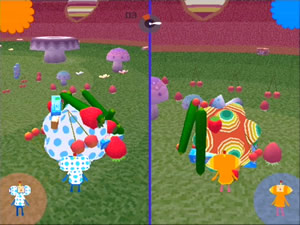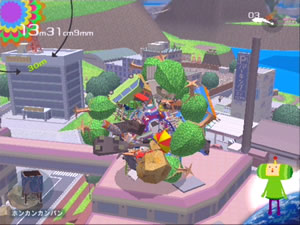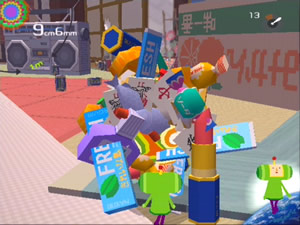Papa wants a rolling stone”
Back in 1989, most gamers were afflicted with Tetris Fever. You remember the symptoms, don’t you? Everywhere you looked, you were greeted by giant geometric shapes just waiting to be dropped into nice, tidy spaces. It was a particularly rough delusion during 5 o’ clock drive time, when the big rig to your right suddenly looked more like one of those sweet four block vertical pieces than an actual motor vehicle. For a solid year, the tiny record player in your head was stuck looping the Tetris
theme.
We all got past it, but I’m afraid there’s a new epidemic en route. I call it the Katamari
Flu. There is but one symptom: an obsessive desire to roll everything you see into an enormous ball while incessantly humming patently retarded Japanese pop songs. The only cure, unfortunately, is to lock the door, take lots of drugs and pray for sleep. And then take more drugs.
I’m referring, of course, to Namco’s latest import from those brilliant maniacs overseas, Katamari
Damacy. Equal parts kitschy toy, dung beetle simulator and psychic laxative, this odd little gem from Japan just goes to show that no matter how many games you’ve played, you have not yet played them all.
A freakish gargantua of a man dressed in absurdly tight clothes and sporting
a cape straight out of the Liberace estate, the King
of All Cosmos is sassy,
exhausted, and your father. One day, Dad loses his mind for a few hours and
careens across the night sky, obliterating all the stars. You play his son,
the pint-sized Prince, and set about helping your queer pa fix the heavens
by building new stars from materials found on Earth. You accomplish this task
by rolling a sticky ball called a “katamari” (Japanese
for “clump of stuff”) in various locales, collecting anything and everything
you see, in an effort to make the biggest stars possible.
Take more drugs – you’re gonna need “em.
Now that you’re sufficiently inebriated, you can forget about the ridiculous backdrop and concentrate on the addictive, simple gameplay. On each of the game’s 15 or so levels, Dad explains the scenario through some offbeat, well-written dialogue (he is a sassy, sassy man, even in text), gives you a set amount of time and a required size for the katamari, then plops you into the thick of things and lets you roll until you can roll no more. This is handled using the two analog sticks operating in tandem like tank controls, a very intuitive system that allows for even the most casual gamer to efficiently get moving in no time. A few extra moves are here as well, including the handy 180 feature and the ability to jump in the air to get a better view of the land. For the most part, though, you just roll, roll, roll.
And as you do, you grow, grow, grow. Provided they’re small enough, things stick to the katamari and become part of its mass. You’ll pick up tacks, coins and candies, then roll over a pencil, and suddenly your ball will have a big oblong object sticking out the side making it roll funny. Roll up more stuff, though, and you’ll get bigger, and bigger, and bigger, until that pencil is covered up by all kinds of other stuff.
Part of Katamari‘s genius is the way in which it determines if an object can merge with your ball. Every object in the game ” and there are literally thousands of objects ” is ranked by the size at which it can be rolled up. You’ll bump into a bucket that’s just barely too large, then go roll off for a while picking up some pineapples or something, and then – joy of joys! – the bucket connects. The game is a series of small victories.
 It
It
is also a reminder that the bigger they are, the harder they are to avoid, and
therefore the scarier they become. Katamari Damacy goes from cute and
innocent to aggressive and terrifying in a matter of minutes. You start off as
a little 5 cm peanut rolling along the floor nabbing shirt buttons and Mahjong
tiles while avoiding big nasty animals like house cats, but you’ll soon grow
large enough to teach those dumb kitties a lesson. Bigger and bigger you grow,
eventually inhaling people, who in turn scream in terror as they become assimilated
into your sphere. By the later levels, you’ll grow to staggering proportions,
a massive wrecking ball picking up cars, houses, planes, whales, and even chunks
of nature itself. How much does a cloud weigh, exactly?
You can actually figure that out thanks to the game’s object library. Open it up and you can see every object you’ve collected, categorized by weight or type, including hysterical little captions describing their usage in life. I didn’t know what umbrellas truly did until Katamari Damacy explained it.
And it showed me, too. Katamari‘s graphics are blocky and colorful, a Fisher Price toy chest come to life. I wouldn’t go so far as to say they are good, provided you care much about fancy textures and slick effects, but underneath the simple, overly angular surface lies a very complex engine. Every object retains its form, which means the game is constantly trying to keep up with the ever-changing physics of your katamari. Since everything ” and I mean everything ” can be incorporated into your ball, there are endless combinations and arrangements, yet the game handles it seamlessly.
The only snag here is the game’s camera. While it does a fine job pulling our periodically to respect your increased size, it has a tendency to get stuck behind objects when you’re smaller. Your view will occasionally be obstructed entirely in the early levels, although this issue does resolve itself later on.
Katamari Damacy is simply oozing with a bizarre, Japanese schoolgirl style
that’s
at once endearing, creative and insane. The intro movie is filled with cows,
fish, and rainbows. Cut-scenes of a
blockheaded family traveling across the world to visit their father as he
blasts off for the moon break up the levels. The front end menu has the Prince
running about on his home planet, then zipping through space to choose a level
on Earth or to visit the giant space mushroom to play some decent split-screen
multiplayer. Mmm. Space mushroom. Fitting.
 Nothing, however, could explain the game’s choice in music. This is, without a doubt, my favorite video game soundtrack ever. The theme song is catchy and screwy and crops up in about three different refrains, while the other tunes are all distinctly Japanese, categorically groovy, and will permanently rent space in your frontal lobe whether you like it or not. I have been singing these songs since I first played a preview build in early August, and I think I’m the better person for it. Sadly, you can only access the playlist when you beat the game, but it’s a small price to pay, really.
Nothing, however, could explain the game’s choice in music. This is, without a doubt, my favorite video game soundtrack ever. The theme song is catchy and screwy and crops up in about three different refrains, while the other tunes are all distinctly Japanese, categorically groovy, and will permanently rent space in your frontal lobe whether you like it or not. I have been singing these songs since I first played a preview build in early August, and I think I’m the better person for it. Sadly, you can only access the playlist when you beat the game, but it’s a small price to pay, really.
Otherwise, the sound is as weird as everything else. The effects are pretty sparse
up until you start grabbing large living things, at which point the game sounds
like one of those little boxes you turn upside down to make it go “moo.”
But in this case, it’s a whole barnyard filled with agitated animals. Yikes.
Though he only speaks through text, the King’s voice is handled by a very cool
record scratch.
Katamari Damacy is not a long game, and while the straightforward split-screen multiplayer extends it bit, the replay value is a little suspect. You can eventually unlock “Eternal’ modes for a few levels (which takes out the time and size requirements), but I think a sandbox mode would have greatly aided the game’s longevity. You’ll wish you could explore the whole world in one continuous roll rather than having to do it in broken up levels. It’s not really a skill-based game, and although you will definitely get better the more you play, don’t expect your competitive edge to sharpen.
However, that’s a fairly minor complaint for such a major game, and considering
the absurd $20 price tag, it’s a no-brainer (or damaged brainer, I should say).
There’s really nothing else out there remotely like it, and if strange Japanese
things are your bag, you simply cannot do any better than Katamari Damacy.
It’s fun, weird and fabulous – a sickness certainly worth catching.











